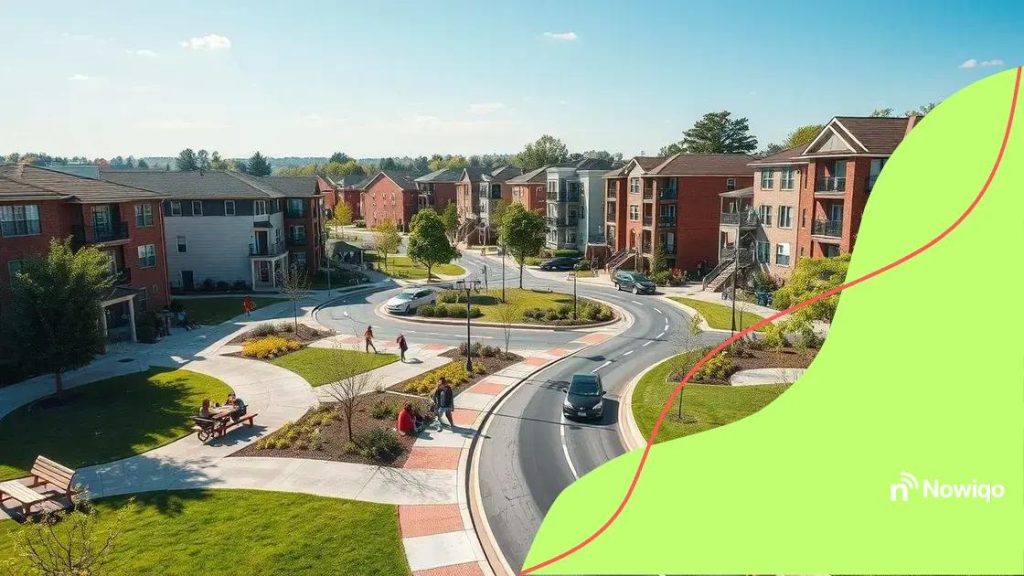Infrastructure law’s effects on communities and what they mean

Anúncios
Infrastructure law’s effects on communities include enhanced economic growth, improved safety, and increased sustainability, making them essential for creating vibrant and resilient neighborhoods.
Infrastructure law’s effects on communities are far-reaching, impacting daily life in ways we often overlook. Curious how these laws shape our neighborhoods? Let’s dive in and see what changes they bring.
Anúncios
Understanding the infrastructure law
Understanding the infrastructure law is crucial for grasping its potential impacts on our communities. This law encompasses various aspects of public works, including roads, bridges, and public transportation. It aims to improve these essential services, affecting how we live and move.
The purpose of the infrastructure law
The primary goal of the infrastructure law is to revitalize aging structures and invest in new projects. By doing this, it creates jobs and stimulates economic growth. Investing in infrastructure leads to safer, more efficient systems that benefit everyone.
Key components of the infrastructure law
- Modernization of transportation networks
- Upgrades to energy systems
- Investment in water and broadband systems
- Support for climate resilience
These components work together to enhance public safety and overall quality of life. For example, improved roads reduce travel time, while upgraded energy systems can lower utility costs.
Anúncios
Funding and support
Funding for the infrastructure law comes from multiple sources, including federal funds and local government investments. This collaborative effort ensures that projects are sustainable and beneficial to diverse communities.
The impact of this law goes beyond mere construction. It plays a critical role in creating jobs and promoting regional growth. More jobs mean a more robust economy, which in turn leads to better infrastructure funding in the future.
As communities adapt to these changes, we will see a shift toward more sustainable practices. This shift is vital for meeting modern economic and environmental challenges.
Key benefits of improved infrastructure
Improved infrastructure brings several key benefits that affect communities in meaningful ways. A strong infrastructure system not only supports daily activities but also enhances overall quality of life. Let’s explore how these improvements create positive changes in our lives.
Economic growth
One of the most significant benefits of improved infrastructure is fostering economic growth. Better roads, bridges, and public transport systems mean more efficient movement of goods and people. This efficiency can lead to increased business productivity and job creation.
Enhanced safety
Upgraded infrastructure contributes to enhanced public safety. Well-maintained roads and bridges reduce the risk of accidents and extend the lifespan of these structures. Moreover, reliable public transport reduces congestion and promotes safer travel.
- Reduced traffic congestion
- Fewer accidents on roads
- Safer public transport systems
- More accessible emergency services
By ensuring safety, communities can cultivate a more conducive environment for families and businesses. The focus on enhancing safety helps attract new residents and investments.
Environmental sustainability
Another critical benefit is the emphasis on environmental sustainability. New infrastructure projects often include green technologies and materials. These innovations reduce carbon footprints and promote a healthier ecosystem. This shift is essential as communities become more focused on sustainability to combat climate change.
As these benefits become apparent, residents are likely to feel a sense of pride in their communities. With improved infrastructure, they can enjoy better services and amenities that enhance their daily lives. Ultimately, these changes foster a more interconnected and vibrant community.
Challenges faced by communities

Communities face several challenges as they adapt to changes brought about by infrastructure laws. These challenges can affect daily life and overall community well-being. Understanding these issues helps us find effective solutions.
Funding limitations
One major challenge is the funding limitations that many local governments experience. Infrastructure projects often require significant investment, which may not be available. This situation can lead to delays or incomplete projects, leaving communities with outdated systems.
Displacement of residents
Improvement projects can sometimes result in the displacement of residents. As neighborhoods are upgraded, lower-income families may be unable to afford rising costs. This displacement disrupts community ties and can push vulnerable populations further away from essential services.
- Loss of affordable housing
- Increased living costs
- Social instability
- Disruption of local culture
Addressing displacement requires thoughtful planning and community involvement to ensure that existing residents benefit from new projects rather than being forced out.
Environmental concerns
An additional concern is the potential for environmental damage. Infrastructure projects can lead to environmental degradation if not managed properly. This may include pollution, habitat loss, and increased carbon emissions. Communities must balance development needs with environmental protection.
As these challenges unfold, ongoing dialogue between community members and policymakers is essential. By working together, they can navigate these obstacles and create solutions that enhance community resilience.
Case studies of successful implementations
Examining case studies of successful implementations provides valuable insights into how infrastructure laws can transform communities. These examples showcase how strategic planning and community engagement lead to positive outcomes.
Case Study: Infrastructure Revitalization in City A
In City A, a comprehensive infrastructure improvement plan was initiated to address aging roads and public transport systems. Over five years, the city upgraded key roadways and expanded public transit routes. This project resulted in increased access to jobs and services for residents, reducing commute times significantly.
- Job accessibility improved by 30%
- Public transit usage increased by 50%
- Local businesses reported higher sales
This revitalization illustrates how well-planned infrastructure can enhance the quality of life for residents and stimulate local economies.
Case Study: Eco-Friendly Transportation in City B
City B implemented a green transportation initiative focusing on bike lanes and pedestrian paths. By allocating funds towards eco-friendly transportation options, the city promoted a healthier and more sustainable way of commuting.
As a result of this project, the city saw:
- Reduction in traffic congestion by 40%
- Decrease in pollution levels
- Increased community engagement in wellness activities
The emphasis on sustainability not only improved air quality but also fostered a sense of community among residents who engaged more frequently in outdoor activities.
These case studies highlight the importance of infrastructure laws in shaping communities. They demonstrate that with thoughtful planning and collaboration, infrastructure improvements can lead to lasting benefits.
Future outlook for communities
The future outlook for communities under the influence of infrastructure law is promising yet complex. As projects evolve, they hold the potential to significantly enhance living conditions. However, they also require careful planning and ongoing community involvement.
Technological advancement
One key aspect shaping the future is the integration of technology into infrastructure. Smart city solutions, such as real-time traffic management and energy-efficient systems, are becoming more prevalent. These innovations allow communities to operate more efficiently, improving the quality of life.
Community engagement
Active participation from residents plays a vital role in the success of infrastructure projects. When community members are involved in decision-making, they feel a sense of ownership. This leads to better outcomes, as projects are tailored to meet the specific needs of the population.
- Increased public forums for discussions
- Collaboration with local organizations
- Feedback surveys to gauge community sentiment
Engaging the community can mitigate challenges, such as displacement and funding concerns. It builds trust and helps ensure that the benefits of new infrastructure are shared.
Sustainability initiatives
The future also emphasizes sustainability. As climate change impacts communities, there is a growing shift towards green infrastructure. This includes using sustainable materials and creating public spaces that promote environmental health.
Investing in renewable energy and eco-friendly practices will likely become a priority. These initiatives not only help combat climate change but also foster long-term resilience in communities.
As we look ahead, the integration of technology, community involvement, and sustainability will shape how infrastructure impacts lives. By focusing on these areas, communities can build a bright and inclusive future for all their residents.
In conclusion, the effects of infrastructure law on communities are profound and far-reaching. By focusing on technological advancements, community engagement, and sustainability, we can create a brighter future for all. Engaging local residents in planning ensures that projects meet their needs while promoting inclusivity. As we move forward, it is essential to balance progress with environmental stewardship, ensuring that the benefits of infrastructure improvements are shared among all community members. Together, we can build a better tomorrow.
FAQ – Frequently Asked Questions about Infrastructure Law’s Effects on Communities
What are the primary benefits of improved infrastructure?
Improved infrastructure enhances economic growth, increases safety, and fosters environmental sustainability, leading to a better quality of life for residents.
How does community engagement impact infrastructure projects?
Active participation from community members ensures that projects meet local needs and fosters a sense of ownership, leading to better outcomes.
What challenges do communities face when implementing new infrastructure?
Communities can face challenges such as funding limitations, potential displacement of residents, and environmental concerns that must be addressed during planning.
What technological advancements are shaping future infrastructure?
Technological advancements like smart city solutions help optimize transportation and energy systems, making communities more efficient and sustainable.